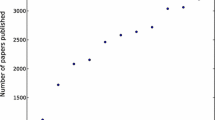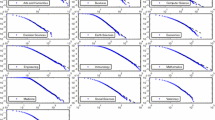Abstract
Statistical distributions with heavy tails are ubiquitous in natural and social phenomena. Since the entries in heavy tail have unproportional significance, the knowledge of its exact shape is very important. Citations of scientific papers form one of the best-known heavy tail distributions. Even in this case there is a considerable debate whether citation distribution follows the log-normal or power-law fit. The goal of our study is to solve this debate by measuring citation distribution for a very large and homogeneous data. We measured citation distribution for 418, 438 Physics papers published in 1980–1989 and cited by 2008. While the log-normal fit deviates too strong from the data, the discrete power-law function with the exponent γ = 3.15 does better and fits 99.955% of the data. However, the extreme tail of the distribution deviates upward even from the power-law fit and exhibits a dramatic “runaway” behavior. The onset of the runaway regime is revealed macroscopically as the paper garners 1000-1500 citations, however the microscopic measurements of autocorrelation in citation rates are able to predict this behavior in advance.
Similar content being viewed by others
References
M.E.J. Newman, Contemporary Phys. 46, 323 (2005)
D. de Solla Price, Science 149, 510 (1965)
D. de Solla Price, J. Am. Soc. for Inform Sci. 27, 292 (1976)
S. Redner, Eur. Phys. J. B 4, 131 (1998)
S. Lehmann, B. Lautrup, A.D. Jackson, Phys. Rev. E 68, 026113 (2003)
K. Borner, J.T. Maru, R.L. Goldstone, Proc. Natl. Acad. Sci. USA 101, 5266 (2004)
A.F.J. van Raan, Scientometrics 63, 549 (2005)
M.E.J. Newman, Eur. Phys. Lett., 86, 68001 (2009)
G.J. Peterson, S. Presse, K.A. Dill, Proc. Natl. Acad. Sci. USA 107, 16023 (2010)
M.L. Wallace, V. Lariviere, Y. Gingras, J. Informetr. 3, 296 (2009)
J.C. Phillips (2009) Topology and the Web of Twentieth Century Science, http://arxiv.org/abs/0909.5363v1
J. Laherrere, D. Sornette, Eur. Phys. J. B 2, 525 (1998)
S. Redner, Physics Today 58, 49 (2005)
M.J. Stringer, M. Sales-Pardo, L.A.N. Amaral, PLoS ONE 3, e1683 (2008)
F. Radicchi, S. Fortunato, C. Castellano, Proc. Natl. Acad. Sci. USA 105, 17268 (2008)
A.M. Petersen, F. Wang, H.E. Stanley, Phys. Rev. E 81, 036114 (2010)
A. Clauset, C.R. Shalizi, M.E.J. Newman, SIAM Rev. 51, 661 (2009)
Q.L. Burrell, Scientometrics 64, 247 (2005)
J. Mingers, Q.L. Burrell, Inform. Proc. Managem. 42, 1451 (2006)
W. Glanzel, J. Informetr. 1, 92 (2007)
A.F.G. van Raan, Physica A 298, 530 (2001)
C. Tsallis, M.P. de Albuquerque, Eur. J. Phys. B 13, 777 (2000)
L. Egghe, R. Rousseau, Progr. Nat. Sci. 13, 478 (2003)
A. Blank, S. Solomon, Physica A 287, 279 (2000)
O. Malcai, O. Biham, S. Solomon, Phys. Rev. E 60, 1299 (1999)
O.S. Klass, O. Biham, M. Levy, O. Malcai, S. Solomon, Eur. Phys. J. B 55, 143 (2007)
R. Albert, A.L. Barabasi, Rev. Mod. Phys. 74, 47 (2002)
P.L. Krapivsky, S. Redner, F. Leyvraz, Phys. Rev. Lett. 85, 4629 (2000)
S.N. Dorogovtsev, J.F.F. Mendes, A.N. Samukhin, Phys. Rev. Lett. 85, 4633 (2000)
M. Levy, S. Solomon, Int. J. Mod. Phys. C 7, 65 (1996)
Z.F. Huang, S. Solomon, Physica A 294, 503 (2001)
Y. Louzoun, S. Solomon, Physica A 302, 220 (2001)
C. Cattuto, V. Loreto, V.D.P. Servedio, Europhys. Lett. 76, 208 (2006)
G. Yaari, S. Solomon, K. Rakocy, A. Nowak, Eur. Phys. J. B 62, 505 (2008)
D. Challet, S. Solomon, G. Yaari, Economics 3, 1 (2009)
Y. Dover, S. Moulet, S. Solomon, G. Yaari, Risk Decisions Anal. 1, 171 (2010)
Author information
Authors and Affiliations
Corresponding author
Rights and permissions
About this article
Cite this article
Golosovsky, M., Solomon, S. Runaway events dominate the heavy tail of citation distributions. Eur. Phys. J. Spec. Top. 205, 303–311 (2012). https://doi.org/10.1140/epjst/e2012-01576-4
Received:
Revised:
Published:
Issue Date:
DOI: https://doi.org/10.1140/epjst/e2012-01576-4




